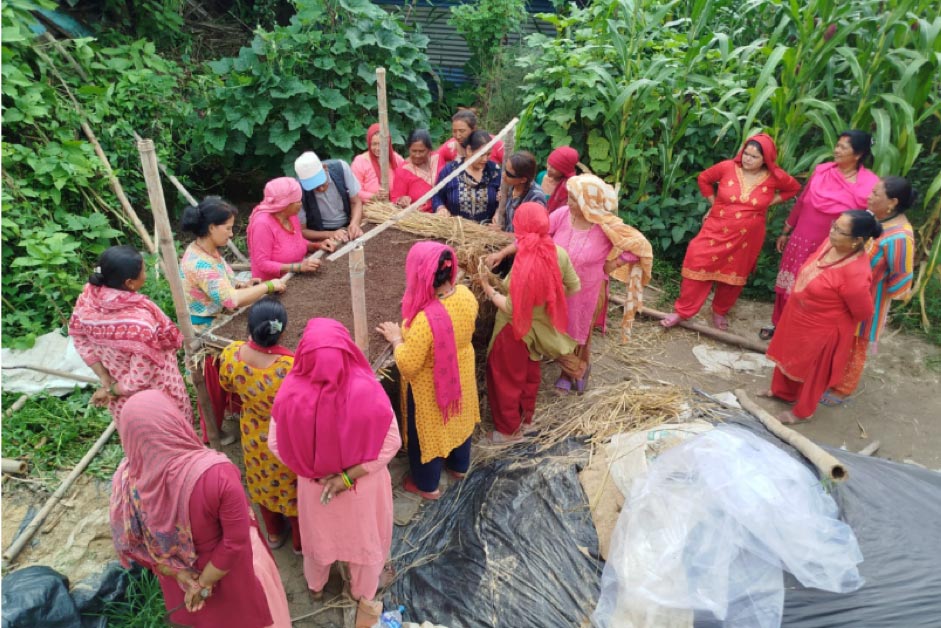Risk to Resilience through Collective Local Actions: Making Cities Resilient (NEXUS)
ISET Nepal, with the financial support of DanChurchAid (DCA) and Changunaryan Municipality, is implementing the “Risk to Resilience through Collective Local Actions (Nexus)“, referring to the priorities of the Sendai Framework for Disaster Risk Reduction (DRR). The project focuses on promoting sustainable and resilient urban development in an area increasingly exposed to disasters due to rapid urbanization, hilly terrain, fragile geology, and the growing impacts of climate change. While the municipality has made significant progress in disaster preparedness and management, it still requires technical expertise, resources, and capacity-building support to strengthen long-term resilience. Collective Local Action refers to the active participation and involvement of local government representatives, the Ward Disaster Management Committee, Tole lane Organizations (TLOs), Humanitarian volunteers, Women champions, Leaders, and Private Sectors.


The project activities are being implemented in the core city and peri-urban areas of the municipality. All the activities of the project, such as open space identification, fire preparedness, air pollution monitoring and mitigation, and preparation of resilience strategy targets to increase preparedness and response capacities of local authorities and communities collaborating with the private sector in the urban context.
The project primarily supports vulnerable groups, such as low- and middle-income families, women, marginalized communities, and the elderly, who face the greatest risks during disasters. NEXUS contributes to Sustainable Development Goal (SDG) 11, which aims to make cities inclusive, safe, resilient, and sustainable. Implemented between 2021 and 2022, this initiative successfully demonstrated how collective local action can reduce recurring disaster risks. The project gained strong interest from both the municipality and local residents because they observed practical, on-the-ground benefits. It also helped strengthen green enterprises during and after challenges like the COVID-19 pandemic, promoted sustainable livelihood practices, and influenced local policy direction toward disaster resilience.
Building on previous achievements, the 2025 phase of NEXUS aims to expand activities focused on institutionalization, livelihood improvement, and capacity building through public–private partnerships (PPPs). These efforts are designed to ensure long-term urban resilience. ISET-Nepal had earlier conducted a major vulnerability study in 2009, which contributed to national understanding of disaster risk. Under the Nexus+ 2025 initiative, the project focuses on four major result areas:
1. Strengthening Preparedness and Response Capacity
This component aims to ensure that communities, the private sector, and local government authorities are better equipped to deal with disasters. Key activities include:
- Raising community awareness through the mobilization of CBOs, CDMCs, and TLOs using participatory hazard and risk assessments (PVCA) in high-risk areas.
- Developing awareness materials such as animations, posters, flip charts, and public service announcements.
- Conducting simulation and mock drills for fire, earthquake, and other priority hazards at schools and community levels.
- Forming a Municipal-Level Tabletop Simulation Working Group.
- Providing capacity-building training to community groups for DRR planning linked with local government processes.
- Implementing community-led, small-scale mitigation measures using Nature-based Solutions (NbS).
2. Improving Disaster Risk Governance
This area focuses on institutional strengthening and policy improvement at the municipal level. Major activities include:
- Technical support to develop or update municipal resilience policies, plans, and strategies.
- Piloting and scaling up the Disaster Resilience Scorecard to support municipal decision-making.
- Capacity-building training for municipal officials to mainstream DRR and climate change adaptation (CCA).
- Facilitating the establishment of a Mayors’ Forum in Bhaktapur to promote inter-municipal collaboration.
- Organizing urban resilience learning and dialogue platforms in collaboration with NDRRMA, MoFAGA, and DPNet.
- Producing policy briefs, documenting best practices, and strengthening municipal disaster information systems by localizing BIPAD and the Vulnerability Monitoring System (VMS).
- Demonstrating a model open and green space equipped with basic infrastructure and guidelines.
- Hosting a national workshop/dialogue on urban open spaces with NDRRMA, DUDBC, and DPNet.
- Implementing road safety and risk reduction activities.
3. Enhancing Economic Resilience of Women and Youth
This component supports livelihood improvement, entrepreneurship, and green economic activities targeting marginalized communities. Activities include:
- Developing a business plan for the Basuki Women’s Group, Chawukhel (Ward 3).
- Supporting farmer groups in adopting agroecological practices.
- Providing training and enterprise development support to Dalit youth groups in Ward 8.
- Conducting skills training for producing soap, surf, and cleaning products, along with enterprise grants for Shrijansil Women Group.
- Offering entrepreneurship training, business plan development support, and access to technology.
- Supporting selected private enterprises to develop Business Continuity Plans (BCP).
- Promoting local agriculture by supporting Haat Bazaars, gift-based vegetable seed distribution, eco-training, composting, and waste management awareness.
- Installing a model composting plant and providing box compost training to farmers.
- Conducting sustainability training for women and youth.
- Carrying out urban plantation activities in Ward 2.
4. Monitoring, Evaluation, Learning, and Capacity Building
This component ensures continuous learning and effective project management through:
- Research and evidence generation.
- Documenting learnings, good practices, and outcome harvesting.
- Regular staff meetings, project reflection sessions (monthly, quarterly, half-yearly).
- Capacity-building activities such as project kick-off workshops and staff trainings.
- Orientation on Core Humanitarian Standards (CHS).


